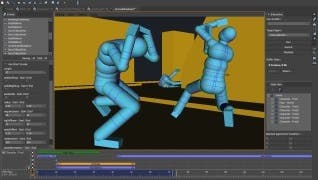NVIDIA, CUDA and PhysX
Music is my hot PhysX.
Now, NVIDIA claims that the fact GPU solutions are cheaper is going to push better GPUs into more business machines. This will help push the idea that an okay CPU/good GPU machine gives better performance than a good CPU/okay GPU, leading to more machines with better GPUs... and so, making more PCs abstractly available for gaming. Or, at least, raising the bottom level of hardware that you can expect people to have.
In terms of a more general use, transcoding video can take hours. Later in July, all GeForce 8000+ cards will ship with Elemental HD, a program which manages to perform the odious task - in the words of NVIDIA - "in a matter of minutes". The software will also be available for people to download online, probably with a small fee ala Quicksave if they already have a GeForce card.
Point being: this CUDA malarkey isn't something that's just for future NVIDIA technology. It's something that allows the hardware many PC gamers already have to be repurposed.
For example, PhysX. NVIDIA's Physics 3D Card system was only supported in a minor fashion, as no-one would buy a card just to make explosions fancier, but with CUDA it can run on one of the other GPUs. A proportion of the 3D card's power can be given over to running physics, giving those fancy PhysX-style interactions without actually having a specific card for it. CUDA's porting to PhysX will become available to the public in July, but developers already have the tools.

You'll be able to - for example - manually, up front, decide to devote a proportion of your 3D card's power to PhysX. Alternatively, developers can commandeer it and do exactly the same thing. The new generation of cards which are about to be announced are able to deal with pretty much anything that exists on the highest setting with power left over, so that power can be given over to acting like a 3D card would.
And it goes further. Where previously you'd have just thrown out your old 3D card when you upgraded your PC to a new one, if you have a G8000+ 3D card already, you can keep it, and just set it to concentrate solely on doing PhysX tasks. This isn't a SLI situation where you need two of the same cards working in tandem - any post-8880 card, rather than being put out to digital pasture, can be given a job of deciding how bits of glass bounce off a skyscraper, or similar. NVIDIA claims it's talking to ATI to try and get them to use CUDA too, which.... well, we'll see there, eh?
The potential is interesting. Demos shown include Natural Motion, whose Euphoria engine is heavily physics-dependent, allowing unique, convincing moments in games. A straight collision isn't enough, as straight ragdolls are ludicrous - the system involving AI (so the hit object will try and move limbs to protect self and similar) leads to impressively naturalistic results. The first sign of this publicly was in Grand Theft Auto IV, but Natural Motion's own American football game, Backbreaker, is a fascinating example of what a physics-heavier approach to collisions can give games. And, with CUDA-esque use of GPUs to do this stuff, the PhysX related boon is accessible to even more of us.
So they did talk some maths, then, but we survived.
